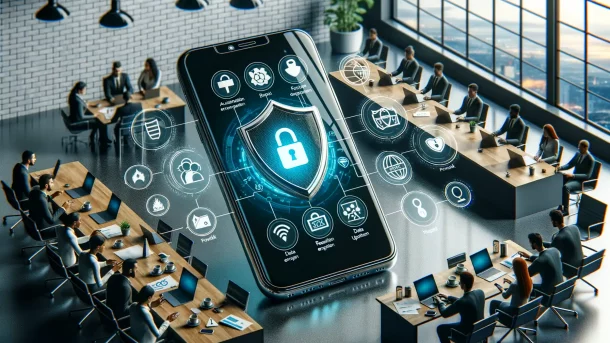Understanding the Challenges of BYOD and Mobile App Security
The BYOD Dilemma: Convenience Meets Complexity
Imagine this: employees tapping away on their personal devices, juggling work emails, sharing files, or joining meetings—all while sitting at home in their pajamas. Sounds modern and efficient, right? That’s the beauty of BYOD (Bring Your Own Device). But here’s the catch: every time a personal device links to your company network, it becomes a potential security Pandora’s box.
Unlike company-issued devices, personal smartphones and tablets come with unpredictable baggage. Different operating systems, outdated security patches, and apps downloaded from dubious sources can create vulnerabilities that hackers dream of. The sheer variety of devices makes it hard for IT teams to keep up.
Top Security Risks Lurking in BYOD Setups
You don’t have to look far to find the risks. Here’s what we’re up against:
- Unregulated apps: Employees might use unsecured apps to access sensitive data, leaving gaps for cyberattacks.
- Data leaks: A lost or stolen device can become a doorway for exposing confidential company information.
- Malware infections: One careless click on a rogue link, and suddenly, your corporate network is compromised.
When it comes to BYOD in the workplace, convenience always has a cost. And in this case, managing both freedom and security requires some clever maneuvering.
Key Strategies to Enhance Mobile App Security in a BYOD Environment

Understanding Risks in the BYOD Landscape
In a world where employees carry the digital equivalent of a Swiss Army knife in their pockets, your mobile app security needs to be as strong as a vault. The “Bring Your Own Device” (BYOD) trend has reshaped workplaces, offering flexibility and reduced costs—but it also invites a tangle of risks if not managed wisely. Think about it: personal devices connecting to sensitive company data may inadvertently create an open invitation for lurking cyber threats.
The challenge? Devices dance between work emails and casual shopping apps, potentially exposing valuable information to prying eyes. With no universal protection across various types of personal phones and tablets, tackling these risks means sharpening your security toolkit. Ready to armor up? Let’s dive into actionable strategies you can implement today.
Tactics to Tighten App Security in a BYOD World
When it comes to safeguarding your mobile apps, a one-size-fits-all approach simply won’t cut it. Here are some proven strategies to outsmart potential threats:
- Secure App Wrapping: This is like giving your apps a protective coat, isolating them from risky environments without altering functionality.
- User Authentication: Enforce multifactor authentication (MFA) to raise the barrier against unauthorized access.
- Regular Updates: Treat updates like vaccinations—essential for blocking ever-evolving vulnerabilities.
By blending these tactics into your process, you’re not just “enhancing security”—you’re wielding a custom shield tailor-made for the BYOD era.
Implementing Robust Mobile Device Management (MDM)

Why Mobile Device Management is Your BYOD Lifeguard
Picture this: your team is scattered across cities, wielding personal smartphones and tablets like modern-day work samurais. It’s powerful, sure, but also a little chaotic, right? Enter the savior you didn’t know you needed — Mobile Device Management (MDM). MDM doesn’t just oversee devices; it’s your digital bouncer, keeping the riffraff out and ensuring every app plays by the rules.
With an MDM solution, you can:
- Enforce secure password policies to keep sneaky prying eyes out of sensitive company data.
- Detect jailbroken or rooted devices before they become security nightmares.
- Remote-wipe lost or stolen devices to stop breaches in their tracks.
MDM at Its Core: A Trustworthy Safety Net
But let me say this—MDM isn’t just about locking things down. It’s about creating harmony between flexibility and protection. You can empower employees to use their own devices while knowing your company’s data stays snug behind ironclad layers of encryption. Imagine scaling a skyscraper with a sturdy harness: that’s MDM for your business. It enables productivity while making sure no one takes any dangerous, unintentional leaps.
And let’s not forget how MDM tools simplify headaches for IT teams, too. From diagnosing issues remotely to rolling out updates en masse, your tech heroes can work proactively without playing whack-a-mole with device vulnerabilities.
Best Practices for Securing Company Data with BYOD

Empowering Employees Without Compromising Security
Imagine this: an employee checks their emails on a personal tablet over coffee at a local café. Convenient, right? But what if that same device lacks proper encryption? Suddenly, your sensitive company data is just another latte spill away from disaster. BYOD (Bring Your Own Device) policies are fantastic for productivity, but they can be a minefield for security. Here’s how to defuse the risks while embracing flexibility.
Clear, enforceable policies should be your first line of defense. Define what’s acceptable in plain language. For example, specify that personal devices must use strong passwords, multi-factor authentication, and updated antivirus software. No exceptions!
Next, make training fun—and frequent. Host interactive seminars or gamify learning about potential threats like phishing scams or unsafe app downloads. Remember, cybersecurity isn’t instinctual; it’s learned!
- Establish secure VPN access for remote work.
- Utilize containerization—basically creating a “work bubble” within an employee’s phone.
- Limit access to sensitive information based on roles.
Trust, but verify. Regularly audit devices and ensure compliance without making employees feel micromanaged. Balancing control with freedom isn’t easy, but when done right, it can feel seamless—like tailoring a suit to fit everyone perfectly.
The Future of Mobile App Security in a BYOD World

The Intersection of Innovation and Security
In a world where you can access work emails while sipping your morning coffee at a cozy café or finalize a sales pitch from your tablet on a flight, BYOD (Bring Your Own Device) isn’t just a trend—it’s the heartbeat of modern work culture. But here’s a sobering truth: with every convenience-packed app that employees download, there’s a shadow. That shadow? Vulnerabilities just waiting to be exploited.
The future of mobile app security in a BYOD universe will revolve around agility. Cybercriminals, like master chess players, are already planning their next move. Developers and companies need to stay three steps ahead. Imagine mobile apps equipped with self-healing capabilities—yes, apps that can detect a breach and repair themselves before harm is done!
Emerging Trends to Watch
It’s not all doom and gloom, though. The cutting edge is packed with dazzling solutions like AI-driven threat detection and dynamic authentication methods. Here’s what’s coming down the line:
- Zero-trust architecture: Assume nothing, verify everything. Access permissions will tighten to a personalized, moment-to-moment level.
- Blockchain-based security: Think tamper-proof transactions and iron-clad encryption at scale.
The result? A seamless blend of innovation and safety where employees continue to embrace their favorite devices, but cyber threats stay locked out in the cold.





